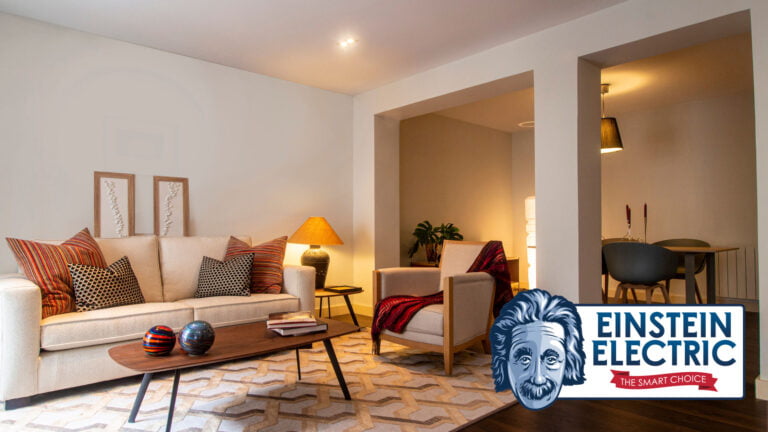Choosing the right lighting for your home can be a daunting task, with so many options available on the market. Lighting not only plays a functional role in illuminating your home, but it also sets the mood and ambiance of the space. In this article, we will explore some tips on how to choose the right lighting for your home.
- Determine the purpose of the room
The first step in choosing the right lighting for your home is to determine the purpose of the room. Different rooms have different lighting needs. For example, you may want bright overhead lighting in the kitchen for cooking, but a dimmer, more relaxed ambiance in the living room for watching TV or entertaining guests.
Determining the purpose of each room in your home is indeed an essential step in choosing the right lighting and optimizing energy efficiency. Here are some common room types and their typical lighting needs:
- Kitchen: The kitchen is usually a functional area where tasks like cooking, food preparation, and cleaning take place. Therefore, it requires bright, well-distributed lighting to ensure safety and facilitate visibility. Installing overhead lighting fixtures, such as recessed or track lights, can provide ample illumination for these activities.
- Living Room: The living room serves multiple purposes, such as relaxation, socializing, and entertainment. Consider using a combination of lighting options to create a versatile space. Use adjustable or dimmable lighting fixtures like table lamps, floor lamps, or wall sconces to provide both ambient and task lighting. This allows you to adjust the brightness based on your specific needs and create a cozy atmosphere when desired.
- Bedroom: Bedrooms are primarily used for rest and relaxation. Soft, warm lighting is generally preferred to create a calming environment conducive to sleep. Bedside lamps or wall-mounted fixtures with dimmer switches are great choices, as they provide localized light for reading or other activities before bedtime.
- Bathroom: Bathrooms require bright, functional lighting for tasks like grooming, shaving, and applying makeup. Overhead vanity lights or wall sconces placed near the mirror can provide adequate illumination. Using energy-efficient LED bulbs in these fixtures can help reduce energy consumption.
- Home Office: Home offices demand ample lighting to support productivity and minimize eye strain. A combination of natural light, task lighting, and ambient lighting is ideal. Position the desk near a window to maximize natural light during the day. Task lighting in the form of a desk lamp with adjustable brightness and directionality is crucial for focused work. Complement it with overhead or ambient lighting to ensure an evenly lit space.
Remember to consider any specific activities or requirements for each room, as they may influence your lighting choices. Additionally, incorporating energy-efficient lighting options such as LED bulbs, smart lighting systems, and motion sensors can further enhance energy savings in your home.
- Consider the style of the room
Lighting can be used to enhance the style and decor of a room. For example, if you have a traditional or classic room, you may want to consider chandeliers or sconces for a more elegant look. Alternatively, if you have a modern or contemporary room, you may want to consider sleek, minimalistic fixtures.
Considering the style and decor of a room is crucial when choosing lighting fixtures as it can greatly enhance the overall aesthetic appeal. Here are some style-specific lighting suggestions:
- Traditional/Classic Style: For rooms with a traditional or classic style, ornate chandeliers or elegant wall sconces can be excellent choices. These fixtures can add a touch of sophistication and timeless charm to the space. Opt for warm-colored bulbs or use dimmers to create a cozy and inviting ambiance.
- Modern/Contemporary Style: In rooms with a modern or contemporary style, sleek and minimalistic lighting fixtures work best. Consider using recessed lighting or track lighting to create a clean and streamlined look. Pendant lights or floor lamps with simple, geometric designs can also complement the modern aesthetic.
- Industrial/Urban Style: Industrial-style rooms often feature raw materials and exposed elements. To enhance this style, consider using pendant lights with metal shades or wire cages. Edison bulbs can add a vintage touch and create a warm, nostalgic atmosphere. Exposed filament bulbs or track lighting can also be great options for highlighting specific areas or objects.
- Rustic/Farmhouse Style: For rooms with a rustic or farmhouse style, consider using fixtures with natural materials like wood, wrought iron, or distressed metal. Pendant lights with mason jar shades or lantern-style fixtures can enhance the rustic charm. Wall-mounted fixtures with vintage-inspired designs can also add character to the space.
- Minimalist/Scandinavian Style: In minimalist or Scandinavian-inspired rooms, opt for clean lines and uncluttered lighting fixtures. Simple pendant lights or track lighting with white or neutral shades can provide ample illumination without overpowering the space. Floor lamps with slim profiles and adjustable features can also fit well within this style.
Remember that while style is important, energy efficiency should not be overlooked. Look for energy-efficient bulbs and fixtures that align with your chosen style to save energy and reduce electricity costs.
- Choose the right type of lighting
There are three main types of lighting: ambient, task, and accent lighting. Ambient lighting provides overall illumination for a room and can come from overhead fixtures, such as recessed lighting or chandeliers. Task lighting is used for specific activities, such as reading or cooking, and can come from table lamps, floor lamps, or under-cabinet lighting. Accent lighting is used to highlight specific features in a room, such as artwork or architectural details, and can come from track lighting or picture lights.
Choosing the right type of lighting for each room is essential to meet specific needs and create the desired atmosphere. Here’s a breakdown of each type:
- Ambient Lighting: Ambient lighting, also known as general lighting, provides overall illumination to a room. It ensures a comfortable level of brightness for everyday activities. Common ambient lighting sources include overhead fixtures like recessed lighting, chandeliers, flush-mount or semi-flush mount fixtures, and pendant lights. To save energy, consider using LED bulbs in ambient lighting fixtures, as they are highly efficient and have a long lifespan.
- Task Lighting: Task lighting is focused lighting that serves a particular purpose, such as reading, cooking, or working. It provides concentrated light in specific areas to aid in performing tasks effectively. Task lighting can come from various sources, including table lamps, desk lamps, floor lamps, under-cabinet lighting in kitchens, or vanity lights in bathrooms. Adjustable fixtures with directional lighting are particularly useful for task-oriented spaces. LED task lighting options are energy-efficient and offer focused illumination.
- Accent Lighting: Accent lighting is used to highlight specific features, objects, or architectural details in a room, adding visual interest and depth. It helps create focal points and enhances the room’s ambiance. Accent lighting fixtures can include track lighting, wall sconces, picture lights, and recessed spotlights. Use accent lighting to showcase artwork, decorative pieces, or architectural elements like textured walls or stone fireplaces. LED accent lighting provides precise illumination while minimizing energy consumption.
When planning your lighting design, consider a combination of these three types to achieve a layered and balanced effect in each room. This allows for flexibility in adjusting the lighting based on different activities and moods. Additionally, incorporating dimmer switches or smart lighting controls can provide further control and energy-saving opportunities by adjusting the intensity of the light as needed.
- Decide on the right color temperature
Lighting color temperature is measured in Kelvins (K) and refers to the warmth or coolness of the light. Lower Kelvin values indicate warmer, yellow tones, while higher Kelvin values indicate cooler, bluer tones. For example, warm white light (2700K-3000K) is often used in living spaces for a cozy, inviting feel, while cool white light (3500K-4100K) is often used in workspaces for a more energizing effect.
Choosing the right color temperature for your lighting can greatly impact the mood and atmosphere of a room. Here’s a breakdown of the different color temperature ranges and their typical applications:
- Warm White (2700K-3000K): Warm white light creates a cozy and inviting ambiance, often associated with traditional incandescent bulbs. It is well-suited for living rooms, bedrooms, and dining areas where a relaxed and comfortable atmosphere is desired. Warm white light can add a touch of warmth and make a space feel more intimate.
- Neutral White (3500K-4100K): Neutral white light falls in the middle range between warm and cool tones. It provides a balanced and natural lighting effect, making it suitable for a variety of settings. This color temperature is often used in offices, kitchens, and bathrooms, where clarity and visibility are important. It can help enhance focus and create a clean, crisp look.
- Cool White/Daylight (5000K-6500K): Cool white light mimics natural daylight and has a bright, energizing effect. It is commonly used in spaces that require task-oriented lighting, such as workspaces, garages, and retail environments. Cool white light can help increase alertness and productivity. It is worth noting that higher Kelvin values (above 5000K) may appear bluish and are often used in commercial or industrial settings.
When selecting the color temperature for your lighting, consider the purpose of the room, the desired ambiance, and personal preferences. It’s also worth mentioning that advancements in LED lighting technology have made it possible to find bulbs that offer adjustable color temperatures. These bulbs allow you to switch between warm, neutral, and cool tones, giving you the flexibility to adapt the lighting to different activities and moods.
Additionally, keep in mind that different lighting fixtures and bulb types may vary slightly in their color rendering, so it can be helpful to test the lighting before committing to a specific color temperature.
- Consider energy efficiency
Energy efficiency is an important consideration when choosing the right lighting for your home. LED lights are the most energy-efficient lighting option available on the market, using up to 90% less energy than traditional incandescent bulbs. Additionally, LED lights have a longer lifespan, which can help you save money in the long run.
Energy efficiency should be a key factor when selecting lighting for your home. LED (Light Emitting Diode) lights are indeed the most energy-efficient option available and offer several advantages:
- Reduced Energy Consumption: LED lights use significantly less energy than traditional incandescent bulbs. They are highly efficient at converting electricity into light, resulting in lower energy consumption and reduced electricity costs. LED bulbs can use up to 90% less energy than incandescent bulbs, which translates into substantial energy savings over their long lifespan.
- Longer Lifespan: LED lights have an exceptionally long lifespan compared to traditional bulbs. On average, LED bulbs can last up to 25 times longer than incandescent bulbs. This means fewer replacements and reduced waste. Longer-lasting bulbs also contribute to lower maintenance costs and hassle-free lighting in the long run.
- Lower Heat Emission: LED lights produce very little heat compared to traditional bulbs. Incandescent bulbs waste a significant portion of their energy as heat, while LED lights convert most of the energy into light. This not only contributes to energy efficiency but also helps keep your home cooler, especially during warm seasons, reducing the load on your cooling systems.
- Diverse Options: LED technology has advanced rapidly, providing a wide range of lighting options to suit various needs and preferences. You can find LED bulbs in different color temperatures, brightness levels, and styles to match the ambiance and design of each room in your home. From warm to cool tones, dimmable options, and even smart lighting features, LED lighting offers versatility and customization.
By choosing LED lights for your home, you can significantly reduce your energy consumption, lower electricity bills, and contribute to a more sustainable environment. While LED bulbs may have a slightly higher upfront cost than traditional bulbs, their energy-saving benefits and longer lifespan make them a cost-effective choice in the long term.
- Don’t forget about dimmer switches
Dimmer switches allow you to adjust the brightness of your lighting to match the mood and activity in the room. They can also help you save energy and prolong the lifespan of your bulbs. Consider installing dimmer switches in rooms where you want more control over the lighting.
- Energy Savings: By installing dimmer switches, you have the flexibility to adjust the brightness of your lights according to your needs. When you don’t require full illumination, lowering the brightness level through dimmers can result in energy savings. Dimming the lights even by 10-20% can lead to noticeable energy conservation. This energy-saving feature is especially beneficial in rooms where bright lighting is not always necessary, such as dining areas, living rooms, or bedrooms.
- Extended Bulb Lifespan: Dimming your lights can help extend the lifespan of your bulbs. The reduced voltage and lower light output associated with dimming result in less stress on the bulbs, leading to prolonged durability. By using dimmers, you can potentially increase the lifespan of your bulbs, reducing the frequency of replacements and lowering maintenance costs.
- Mood and Ambiance Control: Dimmer switches allow you to easily adjust the lighting level to create the desired mood and ambiance in a room. Whether you want a soft, intimate setting or bright task lighting, dimmers offer precise control over the light output. This flexibility enhances the functionality and aesthetics of each space, allowing you to customize the lighting to suit different activities and occasions.
- Compatibility with LED Lights: Dimmer switches are compatible with LED lights, which are already energy-efficient. It’s important to ensure that you choose dimmer switches specifically designed for LED bulbs to ensure proper compatibility and performance. LED bulbs often require dimmers that are compatible with their unique electronic components and low wattage.
When installing dimmer switches, it’s advisable to consult a qualified electrician to ensure proper installation and compatibility with your existing lighting fixtures and bulbs. They can also guide you in selecting the right dimmer switch models suitable for your specific needs.
Incorporating dimmer switches into your lighting design is an excellent way to have more control over the light intensity, save energy, extend bulb lifespan, and create a comfortable and versatile environment in your home.
- Consider the height of your ceiling
The height of your ceiling can impact the type of lighting you choose. For rooms with higher ceilings, consider fixtures that can hang lower, such as pendant lights or chandeliers. For rooms with lower ceilings, consider flush-mounted or semi-flush mounted fixtures that don’t hang down as far.
The height of your ceiling is an important factor to consider when selecting lighting fixtures for your home. Here are some guidelines based on ceiling height:
- High Ceilings: For rooms with high ceilings, you have the opportunity to incorporate fixtures that can hang lower and make a statement. Pendant lights and chandeliers are great choices as they can add visual interest and fill the vertical space. However, ensure that the fixtures are proportionate to the room size and the ceiling height, so they don’t overwhelm the space. Consider adjustable or chain-hung fixtures that can be customized to the desired height.
- Standard or Medium Ceilings: Rooms with standard or medium-height ceilings offer versatility in terms of lighting options. You can choose a wide range of fixtures, including pendant lights, chandeliers, flush-mount or semi-flush mount fixtures, and recessed lighting. Ensure that the fixtures are not too low-hanging, allowing sufficient headroom and maintaining a balanced aesthetic.
- Low Ceilings: For rooms with low ceilings, it’s essential to select lighting fixtures that don’t hang down too far and create a sense of space. Flush-mount or semi-flush mount fixtures are ideal choices as they sit close to the ceiling. These fixtures provide ample illumination while maintaining a streamlined look. Recessed lighting is another excellent option for low ceilings, as it provides a sleek and unobtrusive lighting solution.
It’s worth noting that the size and scale of the room should also be considered alongside the ceiling height. A larger room may require multiple fixtures or larger-sized fixtures to ensure proper lighting distribution. On the other hand, smaller rooms may benefit from compact or smaller-scale fixtures to avoid overwhelming the space.
Additionally, always ensure that the chosen fixtures comply with the recommended clearance requirements for safety purposes. If you’re unsure about the appropriate lighting options for your specific ceiling height, consulting with a lighting professional or interior designer can provide valuable insights and help you make informed decisions.
Considering the height of your ceiling when selecting lighting fixtures will help you create a harmonious and visually pleasing lighting design that complements the proportions of each room.
In conclusion, choosing the right lighting for your home involves considering the purpose of the room, the style of the room, the type of lighting, color temperature, energy efficiency, dimmer switches, and the height of your ceiling. By keeping these factors in mind, you can choose the right lighting to enhance the functionality, mood, and ambiance of your home.





















